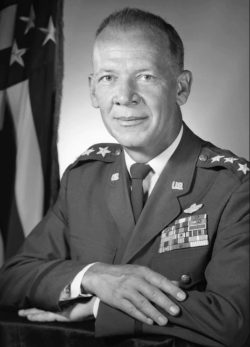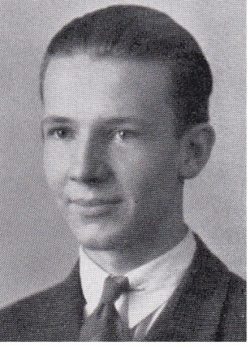
More Recent Photo

Yearbook Photo

More Recent Photo

Yearbook Photo
James Thompson Stewart was born in 1921 and graduated from Roosevelt in 1938. He was a member of the Track team and Aviation Club. He was always interested in airplanes and would often ride his bike from his southside home to Lambert Field to watch planes take off and land.
He then attended the University of Michigan. In 1941 he enlisted as an aviation cadet and received his pilot wings and commission as a second lieutenant in the U.S. Army Air Corps Reserve at Brooks Field, Texas, in 1942. World War II had broken out when Gen. Stewart was offered an appointment to attend the Naval Academy. He turned down the appointment, not wanting to spend the war years in the Academy.
General Stewart was then assigned to the 116th Observation Squadron, Fort Lewis, Wash., where he flew coastal patrol missions in the early months of World War II. In late 1942 he was assigned to B-17 transition training at Geiger Field, Wash., and became an instructor pilot. Shortly thereafter, he was assigned as a flight leader in a newly activated B-17 bombardment group which was sent to England in May 1943. In June 1943 he was appointed commander of the 508th Bombardment Squadron, 351st Bombardment Group, stationed in Polebrook, England, an assignment he held until V-E Day in 1945. Between 1943 and 1945 he completed two highly dangerous combat tours of bombing missions against Nazi-held Europe.
During 1943 Captain Clark Gable and a crew of camera technicians were assigned to General Stewart’s squadron while they were making combat training films of B-17 gunners in action.
After the war, he returned to the Univ. of Michigan receiving a B.S. degree in aeronautical engineering in 1948. In 1960 he attended the Industrial College of the Armed Forces. In 1963 he received an M.B.A. degree from George Washington University.
In 1948, General Stewart was assigned to the Air Proving Ground Command, Eglin Air Force Base, Fla., where for the next four years he held key assignments in operational suitability test organizations. During his tour at Eglin, he helped pioneer techniques for long-range cruise control and dive-bomb delivery of nuclear weapons in jet fighter aircraft.
In 1952 General Stewart was assigned to the Far East Air Forces Headquarters in Tokyo, Japan, to assist with the Korean War. There he helped establish requirements for war materiel, supervised local modifications of equipment, and was a key planner in the development of nuclear delivery capability of F-84 aircraft. During the last year of his tour he was the assistant deputy for operations, FEAF.
In 1955 he was assigned to Headquarters U.S. Air Force, Washington D.C., in a research and development planning and programming capacity and, subsequently, became the assistant for development planning. In 1960 he was assigned to the Air Research and Development Command, Andrews Air Force Base, Md., as assistant for programming, and later as assistant deputy chief of staff for systems when ARDC became the Air Force Systems Command.
In 1962 he returned to Headquarters as executive officer to the deputy chief of staff, research and development. In 1963 he became the director of science and technology. In 1964 General Stewart was assigned to the Office of the Secretary of the Air Force as the director, Office of Space Systems. In early 1967 he was briefly reassigned to the Air Staff as director of space. In March 1967 he assumed duty as the vice director of the Manned Orbiting Laboratory program. He was assigned as deputy chief of staff, systems, Air Force Systems Command, Andrews Air Force Base, Md., in August 1969.
He was promoted to lieutenant general on June 1, 1970, the Air Force’s second highest rank. He then became commander of the Aeronautical Systems Division, Wright-Patterson Air Force Base, Ohio. The division is responsible for developing and buying all Air Force aircraft, engines and atmospheric missiles. An avid golfer, with 4 holes-in-one, he organized annual golf tournaments to support the National Museum of the Air Force in Ohio and hosted a weekly local radio talk show called “Talk to the General.”
For his service during WWII, General Stewart was awarded the Air Medal seven times and the Croix de Guerre. He also was decorated twice with the Distinguished Flying Cross. His many other awards include the Distinguished Service Medal, the Legion of Merit with oak leaf cluster, Bronze Star Medal, Air Force Commendation Medal, Army Commendation Medal, European-African-Middle Eastern Campaign Medal with six service stars, World War II Victory Medal, Korean Service Medal and the United Nations Service Medal.
He is the author of “Airpower – The Decisive Force in Korea,” a book published in 1958.
General Stewart retired in 1976. He passed away in 1990 and is buried in Arlington National Cemetery in Washington, DC. He is survived by a son, James Jr., a former Air Force Captain and retired airline pilot.